Abstract
The Kansas Academy of Science is the second oldest state academy west of the Mississippi. It was founded by John D. Parker,
a young Congregationalist minister, and by Benjamin F. Mudge, who was the foremost
Kansas scientist of the time. The KNHS was established with the intent to increase
and diffuse knowledge of the natural sciences, particularly in relation to the state of
Kansas. Its early existence was quite tenuous. Kansas was still a frontier state
with a small, but growing population and few scientific resources. At the organizational
meeting in Topeka, Mudge was elected the first President, and Parker was elected as
Secretary.
The turning point for the society came in 1870, when its annual meeting was held in Lawrence,
at the University of Kansas. The meeting was well attended, and the decision was made to expand the scope of the organization to include all sciences. The new name, Kansas Academy of Science, became official the following year. In 1873, KAS
became a coordinate department of the State Board of Agriculture. This arrangment resulted
in great benefits for the academy during the remainder of the 19th century. The KAS undertook
several major projects—lobbying for establishment of a permanent geological survey, developing
a science museum, amassing a science library, and publishing the Transactions. The
geological survey finally came to fruition in 1895. The science library and museum were
initially successful, but were later disbanded. The KAS continues to publish the
Transactions, as well as to hold annual meetings and field trips, and to sponsor
other scientific and educational activities.
Introduction and Kansas statehood
The region of Kansas had been a focal point for European exploration and trade since the
expedition by Coronado in 1541. France entered the territory with an expedition by Bourgmont
in 1724, and a permanent French trading post was established in vicinity of modern-day Fort
Leavenworth on the Missouri River—see
Fort de Cavagnial (Hoffhaus 1984). Throughout the first half of the 19th century,
Kansas was a crossroads for travel, beginning with the Lewis and Clark journey up the Missouri River. Other well-worn paths included the Oregon-California trail, Santa Fe trail,
and Smoky Hill trail (Peters 1996). The Pony Express flourished for a brief time, in 1860-61, before the
transcontinental telegraph was completed (through Nebraska).
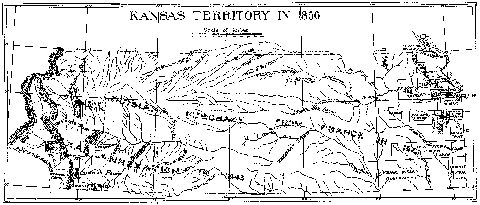 |
| Map of Kansas Territory in 1856. Latitudes 37°N and 40°N
formed the south and north boundaries. The eastern boundary was the Missouri River,
and the territory extended to the continental divide on the west. The western portion
was removed at approximately 102°W when Kansas became a state in 1861. Click on the
small image to see a larger version. |
Kansas achieved statehood in 1861 at the beginning of the Civil War. Following the war, an immigration boom took place
in which the state's population had tripled by the end of the decade. Settlement was aided by
rapid construction of railroads. Still only about 315,000 people resided in the state in 1870,
and the western portions were still in Indian hands. State universities at Lawrence, Manhattan,
and Emporia were new and small. The practice of science was trivial in comparison to rapid
growth in agricultural and economic activity.
Founding of Kansas Natural History Society
The Kansas Academy of Science is among the oldest, continuously active state academies of science in the nation. Only Connecticut and California have older academies. At the time of its founding in the late 1860s, the academy had little likelihood for long-term success (Skelton 1998). The academy was co-founded by a minister and a geologist (Thompson 1885; Bonwell 1969).
John Dempster Parker (1831-1909) was born in Homer, New York, and his family moved to Michigan when he was four years old. He graduated from the University of Michigan, and then taught in Indiana and Illinois for a few years before entering the Chicago Theological Seminary, from which he graduated in 1865 (Willard 1911). Parker was a young Congregationalist minister when he arrived in Topeka in 1867. He was appointed professor of natural science at Lincoln College (now Washburn University). He noted the lack of scientific establishments and resources in Kansas and attempted to organize a society in Topeka. He had little success initially. So he contacted geologist Benjamin F. Mudge at the Kansas State Agricultural College (now Kansas State University) in Manhattan.
Mudge was one of the most influential scientists in Kansas at the time. Mudge supported
the concept, but wanted to move cautiously because a similar attempt to organize an academy
in Michigan had failed recently. A call for an organizational meeting was posted in the
Kansas Educational Journal. The meeting took place on Sept. 1st, 1868 in Topeka; however,
a big storm limited attendence [note 1]. Mudge was elected first President, and Parker was elected
Secretary of the "Kansas Natural History Society" (KNHS). Society goals were stated as:
Increase and diffuse knowledge of the natural sciences,
particularly in relation to the state of Kansas.

| This building was the site of the first meeting of the Kansas Natural History Society at Lincoln College, now Washburn University. The building was still standing in 1903 when this picture was published in the Transactions of the Kansas Academy of Science (vol. 18). Image courtesy of M. Everhart.
|
Parker was trained in theology, but made a lasting mark as an organizer of scientific societies. He published an article about the major earthquake that took place in northeastern Kansas, April 24, 1867 (Parker 1868). From Topeka, he was sent to Kansas City, Missouri as a missionary 1875, where he began organizing the Kansas City Academy of Science. This academy was quite active in the late 1800s (now defunct). In 1881 he was commissioned as a U.S. Army Chaplain and continued to organize scientific societies wherever he was posted. He helped form the
Expansion into Kansas Academy of Science
The KNHS was pitifully small during its first two years. There was little interest and no money. The turning point came in 1870, when Professor Francis H. Snow and Chancellor John Fraser invited the group to meet in Lawrence at the University of Kansas. The meeting was a success, and the mission was expanded to include all sciences. The mission and name change to Kansas Academy of Science (KAS) became official in 1871.
Fraser (1823-1878) was born in Cromarty, Scotland. He was a military general and mathematician, who served as the Chancellor of the University of Kansas from 1867 to 1874 (Merriam 2012). Snow (1840-1907) was born in Fitchburg, Massachusetts and, like Parker, was trained in theology. He took a position at the University of Kansas in 1866 (or early 1867?). In a state with a small population and few scientists, Snow and Mudge agreed to divide their labors. Mudge concentrated on fossils; Snow worked on living organisms.
Snow focused mainly in ornithology and entomology; he became Chancellor of the University of Kansas in 1890. It is a remarkable commentary that Mudge and Snow had such freedom of action and broad-ranging abilities that they could separate their work between geology and biology. It is also noteworthy that two of the four most important people in the early academy were trained in theology. Similar developments would be highly unlikely, in fact, scarcely possible nowadays.
In 1873, the young Kansas Academy of Science became a coordinate department of the Kansas
State Board of Agriculture. Mudge's long friendship with Albert Gray (Secretary of Ag.)
undoubtedly was a factor. KAS received great benefits through this arrangement.
- Office, library and museum space provided in the statehouse until early 1900s (Schoewe 1938).
- State appropriation for KAS budget. Strong state financial support came 1895-1920;
no support in 1920s to early 1930s; and small support again 1933 to 1959, when the
governor vetoed the KAS appropriation for financial irregularities (Skelton 1998).
By the late 19th century, the Kansas Academy of Science was a strong, growing, and influential
organization. During this period, KAS undertook some major projects, which had immediate
impact on science in Kansas (Schoewe 1938).
- Transactions of the KAS – The Transactions of the Kansas Academy of
Science (TKAS) is the official scholarly publication of the academy. It began in
1872 and was a major outlet for all manner of science publication in Kansas during the
late 19th century and first half of the 20th century. As of 1962, more than 22,000 pages
of scientific work had been published, comprising more than 2750 articles by more
than 1400 authors (Schoewe 1965). The TKAS continues today with traditional
paper issues plus online versions (see below).
- Geological survey – A state geological survey existed for only two years in
the 1860s, first under Mudge and then under Swallow. KAS worked consistently to reestablish
a permanent survey. It was promoted on the basis of economic need for raw materials (coal,
salt, oil, etc.) necessary for industrial development. KAS was for three decades the main
outlet for geology in Kansas with more than 110 geological papers published in the TKAS.
A permanent Kansas Geological Survey (KGS) was established finally in 1895 at the University
of Kansas. The KGS has grown to become one of the most respected state geological surveys in
the U.S. (see KGS).
- Science museum – A museum of minerals, fossils, birds, and other specimens
was housed and displayed in the state capitol. The collection was started by Mudge and Snow.
The Kansas mineral display at the St. Louis World Fair won many awards. The museum was
forced to move out of the statehouse, and the collections were damaged and disorganized
during the move. Most of the materials were eventually dispersed to various departments
at the University of Kansas.
- Science library – The need for a scientific library was recognized early. It
was built up through exchanging TKAS issues with other organizations, as well as
direct purchases and private donations. By 1911 at least 6000 bound volumes were shelved,
labelled, and indexed. Friction developed between KAS and the Kansas State Historial
Society because of duplication of holdings and exchanges with other organizations. In
1930, the KAS library was divided among libraries at the University of Kansas, Kansas State
Agricultural College, and Fort Hays State College, to which KAS sold its library for $5000
in order to raise funds for printing of the TKAS.
KAS in the 20th century
The Kansas Academy of Science has experienced growth, periods of instability, and finally a
decline during the 20th century. The strong influence of the late 19th century continued into
the early 20th century, most noteably with the TKAS. However, the library and museum
both eventually were abandoned and dispersed to other state organizations. Financial support
from the state varied from year to year, which led to some lean times. Nonetheless, KAS
leaders and members persevered and the academy gradually grew to a
membership in the range of 600 to
800 in the mid-portion of the century (late 1940s to early '70s). The membership consisted of
a core of science faculty at state universities and science students at those universities.
Mid-century growth of KAS was part of a national trend following World War II. Federal support
for science education and research led to a favorable situation for state universities. Science
was a "golden grail" for the United States through the NASA Apollo missions and other
high-profile programs. However, the latter third of the century has seen a shift in support for science at the federal level and in other facets of society. Military-related research remains strong and biomedical research has grown substantially in the late 20th century (Greenberg 2001). However, the Kansas Academy of Science has never played a significant role in these scientific arenas. The natural sciences have remained relatively constant, in spite of emergence of environmental concerns. Combined with loss of state financial support, KAS has encountered some difficult times in recent decades. Membership declined sharply, and library memberships plummeted, as libraries faced huge cost increases for acquiring scientific journals.
The downward membership trend may be attributed also in part to increasing specialization of scientific disciplines, in which a regional,
all-purpose scientific society holds little interest for many younger scientists and science
students. KAS has gradually developed a natural history emphasis dominated by biology,
geology, and other field sciences. Laboratory and theoretical work comprise only about 20%
of TKAS articles in recent years. On this basis, KAS has slipped out of the
mainstream of modern science. KAS appears to be returning to the original natural history
society from which it began.
During the late 1980s and '90s, KAS leadership undertook several initiatives to
revitalize the academy. Some of the more successful ventures include a fall field-trip
series to a different part of the state each year, a distinguished lecture series, and
online resources, as well as annual meetings and quality publications.

| Fall field trip, Oct. 1995. Participants observe a prairie preserve in the Flint Hills near Cassoday, east-central Kansas. Photo date 10/95; © J.S. Aber. |
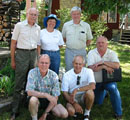
| KAS Council meetings at Lake Kahola, Kansas. Left (2003) – from left, standing: James Taylor, Johanna Foster, Larry Skelton. From left, kneeling: George Potts, Stan Roth and Mike Everhart. Right (2012) – from left: Brian Maricle, Don Whittemore, Sam Leung, Eric Trump, Leland Russell, James Aber, Shaun Schmidt, Mark LaBarge, Lynnette Sievert, Duane Hinton and Richard Schroder. Photos © JSA & SWA.
| 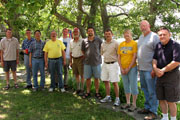
|

Note:

 Table of Contents
Table of Contents

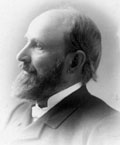
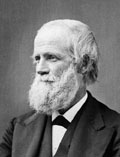




 Related websites
Related websites